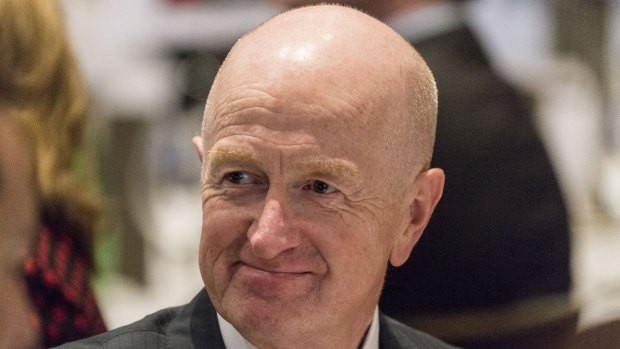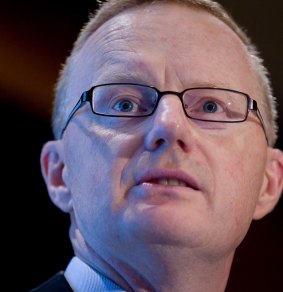This was published 8 years ago
Whoever succeeds Glenn Stevens at the RBA, they'll be on a different planet
By Michael Heath
Australia's next central bank governor will inherit an entirely different set of economic conditions and risks than Glenn Stevens faced when he took the helm a decade ago. The top challenge: getting growth back.
Chances are that task falls to Stevens's deputy, Philip Lowe, according to economists. Glenn Stevens retires next year.

What a difference a decade makes: Stevens' early challenge was to battle excess inflation and set the right policy for the mining boom.Credit: Glenn Hunt
Here's the 10 big differences in the economic environment, international challenges and political backdrop, with 11 months to go until Stevens' term concludes.
Weaker Growth
The economy expanded just 2 per cent in the second quarter from a year earlier, compared with 5.1 per cent in the first year of Stevens' tenure. The International Monetary Fund said last month that, in the medium term, potential growth is likely to be around 2.5 per cent compared with 3.25 per cent in the past.

Deputy governor Philip Lowe is widely seen as Stevens' logical successor.
Export boom busted
Stevens' early challenge was setting policy amid rising prosperity spurred by soaring export prices. He noted in 2010 that a ship-load of iron ore to China could buy 22,000 flat-screen televisions, up from 2200 five years earlier. His successor faces sliding terms-of-trade and a slump in mining investment that the central bank estimates is only half done.
Higher jobless rate
The jobless rate was 6.2 per cent in September 2015, hovering near a 13-year high, compared with 4.5 per cent in Stevens's first full month in office.
Sluggish wage growth
Wage growth, which previously helped ease consumer-debt burdens and boost household consumption, has slowed to a pace that the central bank describes as recessionary. Incomes grew 2.3 per cent in the second quarter from a year earlier, little more than half the 4.2 per cent growth in the same quarter of 2006. The silver lining? The RBA says constrained pay rises are helping keep a lid on unemployment and inflation.
Inflation tamed?
Lowe, if he gets the nod, could be the first governor in more than 40 years who doesn't have to wrestle with excess inflation. When Stevens took the helm in the third quarter of 2006, inflation was 4 per cent -- well above the RBA's target of 2 per cent to 3 per cent. It climbed to 5 per cent in the third quarter of 2008, before the global financial crisis pulled it back. In contrast, prices rose just 1.5 per cent in the second quarter from a year earlier, even as a weakening currency put pressure on the cost of imports.
Different economic risks
Domestically, housing prices are soaring, fuelled by a record-low 2 per cent benchmark interest rate. In Sydney, the average price in September was $920,000, having climbed 23 per cent from a year earlier. Compare that with $477,000 in September 2006.
Andrew Charlton, director of consultancy AlphaBeta in Sydney, says resources now make up more than half of Australia's exports, compared with 2000 when they accounted for less than a third. The country's exports base is at its narrowest since the Korean War wool boom in the 1950s.
On the international front, the key issue is China. While the world's second-largest economy accounted for much of the $1 trillion in extra export earnings that Australia reaped during the mining boom, the Chinese leadership's efforts to transition to consumer-led growth will reverberate here.
Stevens also oversaw a continued winding down of manufacturing -- partly due to Dutch Disease as the resource boom sent the currency to a post-float record of $1.10, making offshore production cheaper. This was capped by auto makers deciding to cease production in the country.
Low interest-rate ammo
Lowe would inherit a lot less policy ammunition to deal with any severe downturn. Stevens took over with the cash rate at 6 per cent and raised it to 7.25 per cent in March 2008. He was able to lower it by 425 basis points during the global financial crisis to 3 per cent to cushion the economy. As growth revived, he tightened to 4.75 per cent in November 2010, before cutting by 275 basis points as the mining boom wound down.
Musical chairs in Canberra
The political environment has become less stable, elevating the status of the central bank and its steady hand on policy. When Stevens took over in September 2006, the same prime minister had run Australia for 10 years. In the intervening decade, the country has had six leaders and its first minority government -- both firsts since World War II.
Fiscal well dry
Not only does Australia lack monetary policy firepower, but its fiscal options are more constrained. In 2006-2007, the country ran a budget surplus equal to 1.6 per cent of gross domestic product, giving the government broad room to stimulate the economy to avert the 2009 global recession. In fiscal 2015, the budget position had reversed to a deficit equal to 2.5 per cent of GDP.
Currency blessing
On the plus side, the Aussie dollar has dropped by about a quarter in value over the past two years, improving the competitiveness of exporters. Still, with the Aussie trading at US72.65¢, it's not far off the US75.20¢ when Stevens took over in September 2006.
Bloomberg